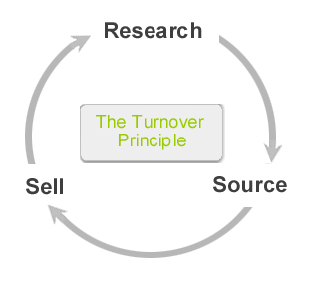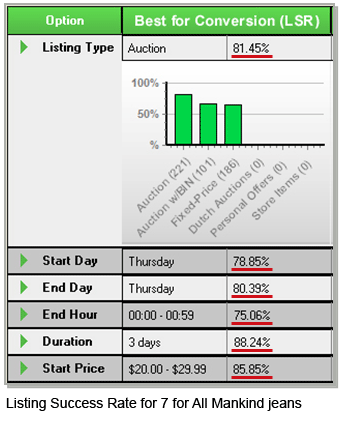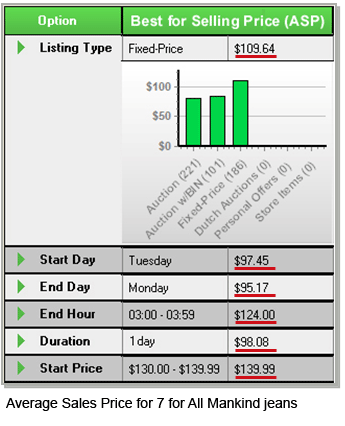Market Research and Product Sourcing Part 3:
Sell, sell, sell!
By Steve Nye, Research Education Specialist and eBay Certified Consultant
This is Part 3 of a three-part series based upon a group of training courses for eBay given at eBay Live by Robin Cowie of Worldwide Brands and Jen Cano of HammerTap. Go here to read Part 1 or Part 2.
Iâve seen it a thousand times. Sellers get in a new inventory and proceed to list every item as fast as they can with no rhyme or reason.
âThe faster I sell my product, the more money I am going to make!â right? Wrong.
Simply put, if you are not using a planned, researched method for listing your products, then you are losing out on profits that could be yours.
Up to this point, you have learned how to remove the guesswork when it comes to finding products to sell. Instead of blindly buying a truckload of random widgets, you know exactly which widgets are going to bring you a profit.
So, if you have removed the guesswork up to this point, why would you slump right back to guessing in the final stage of the Turnover Principle? Iâm telling you, Iâve seen it a thousand times and continue to see it.

You may recall this figure, which illustrates the Turnover Principle. In Part 1, you learned the first step of the process â Research. Using research you can find out exactly what are the top items sold on eBay.
In Part 2 you learned how to efficiently find product sources for the products you researched back in the first step.
Now itâs time to move on to the last step of the Turnover Principle â Sell, Sell, Sell!
Select a Selling Strategy
So whatâs your selling strategy? Youâve done your homework and found a reliable source for a product you know is among the top items sold on eBay, but how do you sell it?
And no, randomly listing is not the answer! If you are going to do that, then donât bother with the strategic researching and sourcing.
You need to develop a selling strategy to fit the needs of your business. Hereâs three examples to illustrate my point.
1. High Volume: Listing Success Rate (LSR)
Strategy: A higher volume of sales yields greater profit in the long-run, even if the profit per listing is less. This strategy is great for bulk items.
2. High Profit: Average Selling Price (ASP)
Strategy: A greater profit per sale yields greater overall profit in the long run, even if the conversion rate is lower. This strategy is great for small inventories or less common items.
3. Balanced: LSR x ASP
Strategy: This strategy tries to strike a balance between increasing conversion rate and earning more per sale in order to get the greatest profit in the long run. This strategy is great for selling common items at non-bulk rates.
Selecting which strategy to use depends upon two main things: how much you paid for your inventory (per item) and how much inventory you have.
Remember our example of womenâs jeans from the first two articles? We found that 7 for All Mankind jeans were hot sellers. Once we found a source, we were ready to make an order. Itâs our order that will help us determine which strategy to use.
Letâs discuss each one of these in greater detail and look at some examples.
Strategy 1: High Volume Sales
Selecting this strategy will enable you to sell a large inventory the quickest. You can only be successful with this strategy if 1) you paid well below the market price for each item and 2) you have a very large inventory you need to sell.
The key with high volume sales is lowering the price (because your cost was low) to sell, sell, sell. Before you know it, you have sold through your large inventory in no time (weâre talking over 100 items here).
In this case, you are concerned about our conversion rate more than you are about price. Therefore, you need to list your items in a way that will bring the greatest Listing Success Rate (LSR). During our research from part 1, we found our average LSR to be 72.44%.
You want to now go back to the research and select the listing options that will increase your LSR to anything higher than 72.44%.

Your research shows you exactly which listing options, such as listing type, is going to increase your LSR. In this case, a Regular Auction listing type will increase your LSR from 72.44% to 81.45%. As you go down the list of options, you will create the perfect combination for your listings to ensure you are maximizing your conversion rates.
Once you have this information specific to this strategy, you can sell, sell, sell!
Strategy 2: High Profit Sales
This strategy is used best for low volume sales where your profit margins really matter. If you only have 10 pair of jeans, then you want to maximize your profits on each pair.
In this case, you want to switch from increasing our LSR to increasing our ASP (Average Selling Price). Your overall average for these jeans was $90.20. Now you want to select those listing options that are going to increase your sales price to anything more than $90.20.

Here you can see that your âbestâ listing type really depends upon your selling strategy. For LSR, the âbestâ listing type was a Regular Auction, but now it has changed to meet a different selling strategy. To increase our selling price, you want a Fixed-Price listing, which is a Buy It Now only auction. This increases your sales price from $90.20 to $109.64, a difference of more than $19.00!
Now you are starting to see why you should take the extra two minutes to do the research to ensure you are maximizing your profits on each sale!
Strategy 3: Balanced
|
A balanced strategy is somewhere in the middle between High Volume and High Profit. Instead of going with one extreme or the other, the balanced strategy takes the happy medium to give you the best success rates and profits over time.
This strategy works best when you are selling the same product over and over again. And itâs done by selecting those listing options that increase both your LSR and ASP by small amounts.
|
Sponsored by:

Click here to get products to sell on eBay right now!
|
Summing it All Up
The bottom line in all of this â remove the guesswork! And to put it bluntly, if you are still running your sales on guesswork, then you are losing profits!
The whole point of researching, sourcing and selling is to remove the chaos of running an eBay business and replace it with sound strategies.
From this series of training courses for eBay you should never have to get stuck with a not-so-hot inventory again. You will also be able to maximize your sales and/or profits depending upon your sales strategy.
|






